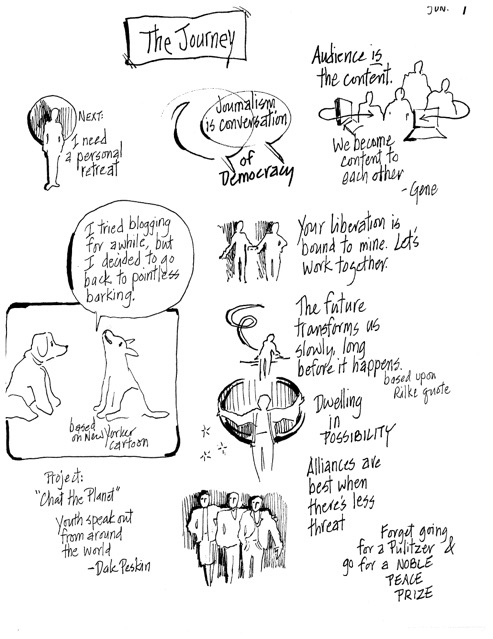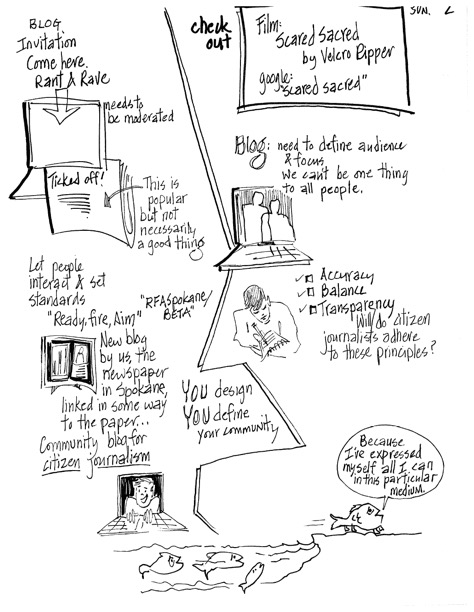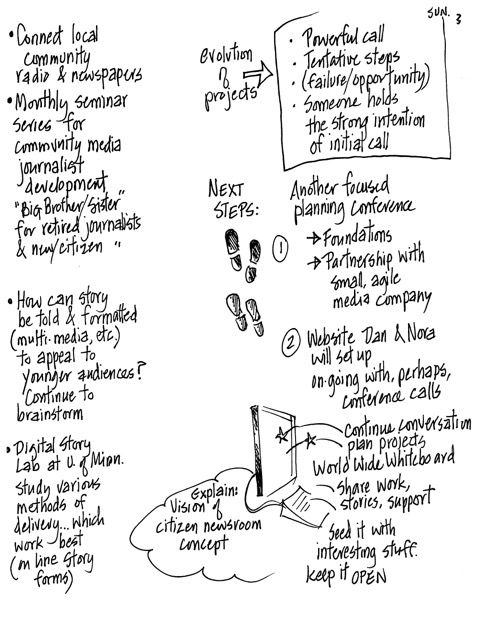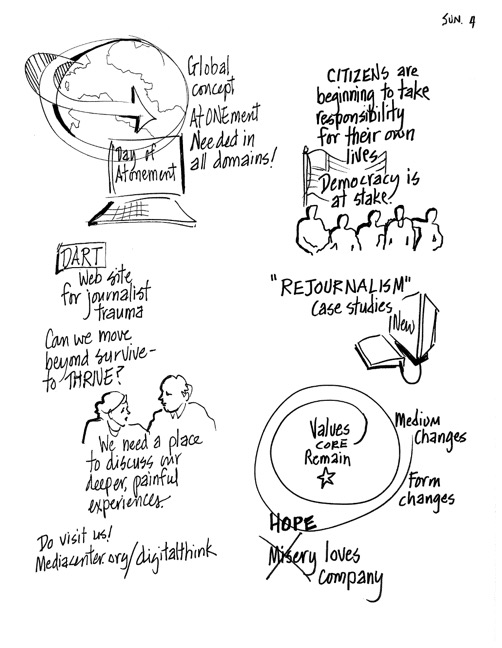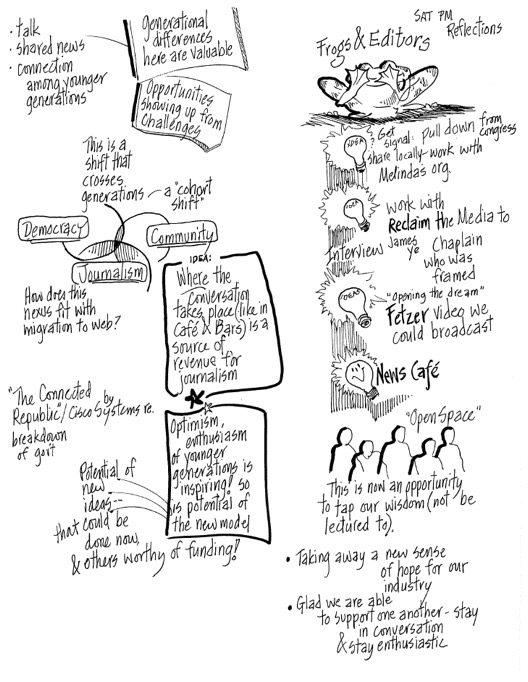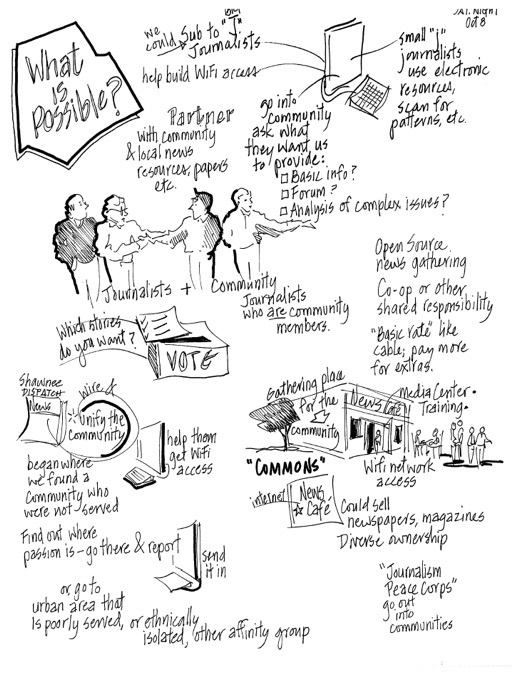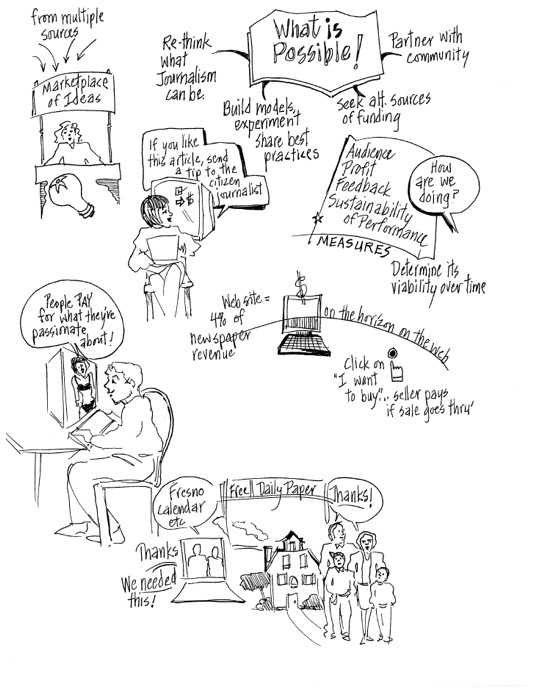Convenor: Melinda Wittstock
Participants: Stacy, Karen, Cindy, Florangela
Summary: We set about to brainstorm what journalism might look and sound like in a new era of multimedia and interactive technology: What new formats could be explored? We talked about how the way people are using media is changing, what people really want from media, and how or whether good storytelling could adapt to the new technologies, such as IMing, Podcasting and cell phones. We all agreed that whatever was created it would have to be good – useful relevant information to specific audiences, technically good, trustworthy and reliable, and fun.
The conversation, in brief:
Cindy: It’s crucial we find ways to rebuild conversation between citizens and elected representatives
Stacy: We need better research to find out how people are using the new devices, how they incorporate into lifestyles and what they want from each device.
Melinda: Technological change happening so fast, it is hard to do the research fast enough; sometimes people don’t know what they want until it is offered to them, but nothing will work unless it is good and useful
Cindy: Reminds us of a story Jean told her about Korean elections and how text messaging in the last 24 hours changed the result
Melinda: Already the ‘war rooms’ of both Democrats and Republicans were relying on such high speed technology as they geared up for Supreme Court nomination fights; it is important technology and formats don’t entirely get hijacked by interest groups or politicians, though that will always be an aspect. People have to know the difference of what they are getting – and from whom.
Stacy: News to phone is something AJC already doing
Florangela: There is a lot of potential on phone or Ipod – but it has to be personality driven. Think Jon Stewart on the Daily Show. I could imagine someone funny but smart reading the news on the phone or Ipod; it could have a ‘cult’ following. But probably has to be tailored to specific audiences and interests. MTV does news and elections differently to reach younger audiences, so this could too. You need to think of the audience: where they go, what they do. Think of Zone ESPN, they have TVs in stalls of bathrooms. People will always go see live music – so content could be very listings driven. But it would need to be narrowly focused.
Melinda: There could be listings, reviews, news, and a means for people to exchange ideas and news items back and forth, much like they IM gossip right now
Stacy: I can’t imagine any interest in public affairs content on the cell in a music club, but on the other hand, in a Jon Stewart type format maybe.
Melinda: That’s just it; it depends how you do it, how you tailor it. News doesn’t have to be dull or boring. Also I think it needs to be tailored to affinity groups: say DC Urban Moms – there is a website, but it could do news that stretches from mommy and me classes to education and health stories.
Cindy: I don’t think the NYT translates, but as long as it is news that affects your life, it could work.
Stacy: I’m agnostic about this; there has to be some point and purpose to the news
Florangela: It all needs to be very short, with new angles
Cindy: Oh My News format – invests people in content; they vote what they want more of; perhaps how the research works
Stacy: It needs involvement, it won’t work unless there is buy-in and participaton
Karen: Immediate personal gratification
Melinda: Danger that stories people don’t want won’t get told – journalists have a responsibility to speak truth to power, hold it to account, and sometimes tell uncomfortable truths. But I also think it is a journalists job to make information engaging, interesting, understandable and enjoyable, even entertaining. It’s to get people to think, not tell them what to think. I think there is a way to tell young people things about their world, by encouraging them to better observe their world, and share their thoughts with others. That conversation, coupled with reliable information they can pass on to each other…well there is potential here I think, but a lot of work to be done…
Stacy: Software exists to encourage and reward participation, but the ‘evil’ side of it is that they later get sold stuff
Cindy: Like old green stamps
Melinda: collecting stuff from cereal boxes
Karen: you can incentivize and build behavior patterns
Cindy: young people interested in Iraq, environmental issues
Melinda: another case of ready fire aim
Melinda: Asks others: what would you do? How would you do a story you are already working on differently if you knew it was for an ipod or cell phone?
Stacy; Is it a one way or two way communication?
Melinda: Could be either or both
Stacy: It has to be short, real time, not necessarily time sensitive – bring news in different contexts
Melinda: it might also be a way of bringing people back to newspapers, radio, TV or just to other internet sites, by whetting their appetite and encouraging them to want more
Karen: it could be viral
Melinda: people are naturally curious, but the onus is on the journalist to find better, new delivery systems to ensure people can get connected to things they didn’t even know they were interested in
Karen: No one is linear anymore in the way they take news; it all has to interconnect
Cindy: My 24 year old son finds stuff and then wants to share with his friends, with me – he’ll say, Mom, you gotta see this…People do share news, and that is an exciting aspect of the new technology in enabling conversation
Stacy: lots here to talk about…
Next Steps:
- Agreed that journalists from print and broadcast need to brainstorm story telling in a different way, to fit myriad technologies – from multimedia and interactive internet content, through to multimedia pod casts, cell phone, text message and IMing. Karen says it is important to see how stories can have “legs”, how they can travel.
- Ready fire aim: start small projects or experiments (Stacy says AJC providing text on phones; might add an interactive loop)
- Continue communication with this group and others from the retreat, and other folks – and try to create these new experimental formats
- Keep questioning!

